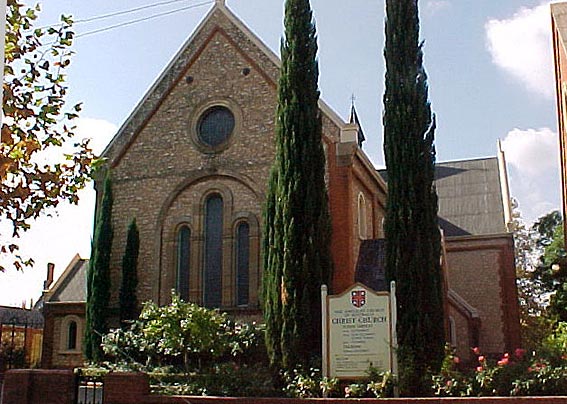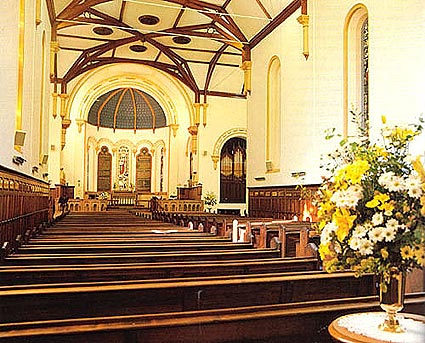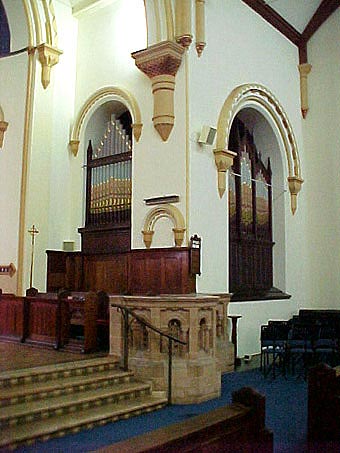Jeffcott Street, North Adelaide
First organ: B. Unknown installed 1854
Rem. 1873, now in Sunset Rock Uniting Church, Stirling
Present organ: B 1873 A. Gern, London; enl 1877;
enl 1885 Fincham & Hobday; enl 1899 J.E. Dodd;
reb 1951 J.E. Dodd & Sons Gunstar Organ Works.
3 manuals, 36 speaking stops, 14 couplers, electro-pneumatic
Overhauled and rev 1982-1991; new console 1998 George Stephens.
Reb & enl 2003 Australian Pipe Organs and George Stephens.
3 manuals, 43 speaking stops, 14 couplers, electro-pneumatic

Notes provided by Mark Joyner (June 2007):
Christ Church North Adelaide was consecrated in December 1849, in the time of Bishop Short and occupies a position adjacent to the current Bishop’s Court, less than a kilometre from St Peter’s Cathedral. Nearby is Montefiore Hill, with its statue of Colonel Light looking-out over his city. The nave was completed to its present length in 1855 and the organ chamber added in 1885. The priests’ vestry, known as the Marryat Vestry, was added much later, in 1961. Complementing these buildings is the equally impressive rectory, which has recently undergone a major restoration. Christ Church is a large and imposing stone building in the Norman style, of cruciform shape, which served as the pro-Cathedral of the diocese, prior to the opening of the Cathedral, in 1877.
The organ has recently undergone a major rebuilding programme. The work was carried out jointly, by Australian Pipe Organs Pty Ltd, (Melbourne) and George Stephens Organ Builder Pty Ltd, (Adelaide). The instrument was officially opened with a splendid recital by Benjamin Bayl, in November 2003. Further voicing, balancing of individual ranks and work to improve the wind system and tremulants was carried out in the months following the recital. At the time of writing, additional work is being discussed with George Stephens; this will involve some re-balancing of certain ranks and regulation and other work to further improve the speech and tone of some stops.
The basis of the current instrument is a small August Gern organ of 12 stops, dating from 1873, being, as far as I can ascertain, the only organ exported to Australia by him. Even with three additional stops provided by Gern four years later, this organ must have struggled to make much impact in the building, even though it was placed in a gallery (since removed), at the western end of the nave. Gern was of course foreman to Aristide Cavaillé-Coll, prior to setting-up his own business in London.
From this organ, the instrument grew, with significant work having been carried-out in 1885, when the instrument was enlarged to three manuals by Fincham and Hobday, 1899 and again in 1951 – by JE Dodd and Sons, Gunstar Organ Works. It was at this time that the organ was electrified, (the action had previously been mechanical), the ‘Tuba’ rank, amongst others, added, (with pipes provided by Palmer, of London) and a new, detached console provided at the front of the nave. Some additional ranks were added in 1974 – a Pedal Mixture, the Great Mixture and some mutations to the Choir and Swell Organs. In the 1980’s, George Stephens carried out repairs to the Great soundboard, which had been damaged by water, and installed solid state switching. The splendid current console, (splendid both as regards looks and player comfort), which is placed on a moveable platform, was made by Graham Stephens and installed by that company in 1998. George Stephens has maintained the instrument since the early 1980’s.

Prior to the 2003 rebuild, the specification was as follows:
| GREAT ORGAN 1. Open Diapason I 2. Open Diapason II 3. Claribel Flute 4. Principal 5. Twelfth 6. Fifteenth 7. Mixture 8. Tuba 9. Octave Tuba SWELL ORGAN 10. Lieblich Bourdon 11. Open Diapason 12. Rohr Flute 13. Gamba T.C 14. Principal 15. Wald Flute 16. Fifteenth 17. Tierce 18. Mixture 19. Trumpet 20. Spare slide Tremulant CHOIR ORGAN 21. Keraulophon 22. Harmonic Flute 23. Harmonic Flute 24. Nazard 25. Harmonic Piccolo 26. Larigot 27. Clarinet 28. Tuba 29. Octave Tuba Tremulant PEDAL ORGAN 30. Sub Bass 31. Bourdon 32. Cello 33. Mixture 34. Trombone 35. Tuba 36. Octave Tuba |
8 8 8 4 2-2/3 2 II 8 4 16 8 8 8 4 4 2 1-3/5 III 8 8 8 4 2-2/3 2 1-1/3 8 8 4 16 16 8 II 16 8 4 |
19.22 15.19.22 (from 8) (from 8) 12.15 (from 8) (from 8) (from 8) |
All the usual couplers were provided, and there were 4 adjustable pistons to each manual, with those on the Great and Swell duplicated as toe pistons.
The recent work carried out at Christ Church has involved virtually all aspects of the organ. Apart from the instrument itself, which was entirely removed, the well-positioned and relatively spacious chamber, dating from 1885, was thoroughly re-furbished. The organ, when reinstalled, was reorientated within the chamber so as to project into the transept, rather than the chancel, thus enabling it to speak more directly into the building.
Broadly speaking the work on the organ involved the wind system - which was completely renewed - new and translated pipework, the installation of a solid state capture system and the revoicing and regulation of certain ranks.
The wind system was unsatisfactory as the unsteadiness was noticeable throughout the instrument. The new capture system has provided the instrument with 6 departmental pistons to each division, 8 generals and 10 levels of memory.
The Swell has gained a new full-length Double Trumpet, to match the revoiced, existing, Cornopean, as well as an Oboe, and undulating string. The swell box itself has been improved (it formerly used the chamber wall as its back), and has had its shutters mounted vertically, to great effect. It now provides a far wider dynamic range.
The Great has gained the former Swell Bourdon, a 4' Flute, a reinvigorated Large Open Diapason and a third rank, (from tenor C), in the re-cast Mixture. The Large Open Diapason was added in the 1951 rebuild and is a Fincham rank. Prior to the 2003 work it was very similar in volume to the Small Diapason. It now has a fuller, rounder tone, like all good Large Diapasons, contrasting with its more harmonically developed partner, and fills-out the full ensemble.
The Choir has gained the Tierce from the Swell, and significant balancing work to enable it and the other (independent) mutations - Nazard and Larigot - to better relate to the stops around them. The resulting Cornet Séparé provides a wonderful new colour to the organ. A further gain to the Choir organ is the marvellous new high pressure Tuba, on 12 inches. The old organ had a stop named 'Tuba', but this was the 8’ and 4' part of what was essentially a Tromba 16’ 8’ and 4’ rank, that serviced the Great and Pedal division, (being also available on the Choir).
On the Pedal the most significant gain has been the addition of a much-needed, (second hand), Open Wood, obtained from an obsolete instrument in Victoria. The scale was increased by one note - a new bottom C was made by APO. To this has been added an extra octave to the Sub Bass, to form a Bass Flute and a new, extended 8 and 4' Principal rank, based partly on the old Pedal Mixture, but also incorporating the Gern pipes from the transept facade, which had been silenced some years ago. The old 'Tuba' rank has been revoiced to a brighter tonality and is still available on Great at 8 and 4' pitches and Choir at 8’ pitch, where it has been renamed 'Trumpet' and also at 16', 8’and 4’ pitch on the pedals.
This rank constitutes the only one that is extended, on the manuals. Although it does service at different pitches, and theoretically shouldn't work, it does so remarkably effectively. As the pedal Trombone it provides a firm and slightly 'open' sound that blends well with the flue work. It is not overly loud, which means it can be used very effectively in Bach fugues for example. On the manuals, it serves as a more effective chorus reed (than it did), with its brighter sound and is a more effective solo stop in many situations, including of course, service playing.
The woodwork of the two facades – to the chancel and transept – now looks resplendent, stripped of its not-very-attractive, former purple-coloured varnish. Under the direction of George Stephens it was repaired as required, with great skill and care (there were many holes and missing bits), and re-coated so as to appear as it now does – with a warm, honey coloured hue. The diapered pipes were cleaned and returned as they were.
The instrument now speaks much more convincingly and tellingly than it did. The additional pipe work blends well with the old and the overall ensemble has an homogeneity and integrity. It can cope very well with much of the repertoire and is a resourceful and colourful instrument for accompanying, both in service playing and other roles. The church’s favourable acoustic enhances its fine qualities. Its improved features and sounds are many, and include:
- A bright and fiery ‘full swell’
- Contrasting and balanced diapason choruses
- Contrasting flute families (including the wonderful, original Gern Harmonic Flutes)
- Added and refined colours from the reeds and mutations. The ‘new’, (second hand) Oboe adds great colour in both ensemble and solo roles
- Characterful and restful swell strings, (the Celeste coming from the old Gamba)
- An improved ‘presence’ in the building.
The instrument can be heard later this year when visiting English virtuoso Thomas Trotter plays it, as part of a visit to Christ Church and Pilgrim Church, in October.

The revised specification is:
| GREAT 1. Bourdon+ 2. Open Diapason I 3. Open Diapason II 4. Clarabel Flute 5. Principal 6. Flute* 7. Twelfth 8. Fifteenth 9. Mixture 10. Trumpet 11. Clarion Swell to Great Great to Pedal Choir to Great SWELL 12. Open Diapason 13. Rohr Flute 14. Viola da Gamba* 15. Vox Celeste TC+ 16. Principal 17. Wald Flute 18. Fifteenth 19. Mixture 20. Double Trumpet* 21. Cornopean 22. Oboe* Swell Octave Swell Sub Octave Swell Unison Off Tremulant CHOIR (Unenclosed) 23. Keraulophon 24. Harmonic Flute 25. Harmonic Flute 26. Nazard 27. Harmonic Piccolo 28. Tierce+ 29. Larigot 30. Clarinet Tremulant 31. Trumpet 32. Tuba* Swell to Choir Choir Octave Choir Sub Octave Choir Unison Off PEDAL 33. Open Wood* 34. Sub Bass 35. Bourdon 36. Quint 37. Principal+ 38. Bass Flute 39. Fifteenth 40. Trombone 41 Double Trumpet 42. Trumpet 43. Clarion Great to Pedal Swell to Pedal Choir to Pedal |
16 8 8 8 4 4 2-2/3 2 II-III 8 4 8 8 8 8 4 4 2 III 16 8 8 8 8 4 2-2/3 2 1-3/5 1-1/3 8 8 8 16 16 16 10-2/3 8 8 4 16 16 8 4 |
19.22.26+ extension of 10 15.19.22 from Great (hp) from Great from 34 from 34 from 37 from 10 from Swell from 10 from 10 |
Pipes 61 61 61 61 61 61 61 61 171 73 - 61 61 61 49 61 61 61 183 61 61 61 61 61 61 61 61 61 61 61 - 61 30 42 - - 42 - - 12 - - - |
6 adjustable thumb pistons to manuals
8 adjustable general thumb pistons
6 adjustable toe pistons to pedal
6 toe pistons duplicating generals
Great to Pedal reversible thumb and toe pistons
Swell to Great reversible thumb and toe pistons
Choir to Great reversible thumb piston
‘Trombone 16’ reversible toe piston
General Cancel thumb piston
Balanced electro-pneumatic swell expression
10 levels of memory
Electro-pneumatic action
* new stops
+ stops that are partly new, or that have been used differently
Mark Joyner (June 2007)